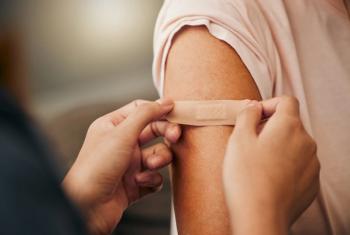
COVID-19: How to use telehealth for patient visits
Contemporary Pediatrics spoke with Andrew J. Schuman, Editorial Advisory Board member, clinical assistant professor of Pediatrics, Geisel School of Medicine at Dartmouth, Lebanon, New Hampshire, and practicing pediatrician, about incorporating virtual patient visits-telehealth-into one’s pediatric practice during these times of social distancing and self-quarantine.
Earlier this month Contemporary Pediatrics spoke with Andrew J. Schuman, Editorial Advisory Board member, clinical assistant professor of Pediatrics, Geisel School of Medicine at Dartmouth, Lebanon, New Hampshire, and practicing pediatrician, about incorporating virtual patient visits-telehealth-into one’s pediatric practice during these times of social distancing and self-quarantine.
Dr. Schuman also spoke about tackling the issues that arise when a pediatrician can't physically examine a patient and how to manage potential payment issues.
Q. Dr. Schuman, for pediatricians who are utilizing telehealth for the first time because of the COVID-19 pandemic, how can they ensure a successful transition?
Dr. Schuman: First and foremost, I think pediatricians need not be fearful. Telehealth is very easy to implement. It is something that you get used to very quickly, and patients appreciate the fact that you're reaching out to them. You see them, they see you, and it cements the relationship that you've established over weeks and months with your patients.
Telehealth is an awesome service. The way to implement telehealth is to download and install and subscribe to any of a number of telehealth services. There are innumerable ones available. Zoom, for example, has a new service, and Zoom is awesome and affordable. So, I would recommend that pediatricians consider that one. There are also programs such as SnapMD, Anytime Pediatrics, Doxy.me-a whole bunch of applications available.
You connect to the patient by way of a virtual waiting room, and then you communicate with them as you would in a typical FaceTime or Google Duo type of interaction. I usually recommend using a smart device like a phone or a tablet so you can see the patient while you're on your computer and looking at the chart so you can review the information with them, confirm their pharmacy.
It's also important to realize that there are limitations to the telehealth visits in terms of what you can see and not see, but I am very impressed by the ability of pediatricians to deal with patients who are ill by way of telehealth. Pediatricians have used telehealth in the past for managing patients on ADHD meds or meds for anxiety or depression, but over the last few weeks, I've adapted my practice to see mostly patients who are ill. Also, the skills that pediatricians have acquired over years are very useful in communicating with patients and evaluating patients with ill visits. So, it's something that pediatricians should not be fearful of and can get used to very quickly. Patients appreciate the fact that they can communicate with their established pediatrician as opposed to someone unfamiliar, such as at an urgent care facility.
Q. What are the insurance payment issues that a pediatrician might face with telehealth services and what can they do to potentially prevent these issues from popping up?
Dr. Schuman: Telehealth has been around as an option for practices for many years, and through the request of primary care providers, states have dealt with requests from doctors to get phone co-payment at parity for telehealth visits. Each state is dealing with this in its own way. In my state of New Hampshire, after pediatricians and primary care providers pushed for legislative reform, we now can provide telehealth visits to patients with a physician at a medical facility or a physician in his/her home and the patient at their home. That did not used to be. In the past, telehealth was limited to patients in medical facilities.
There's been an evolution and revolution in telehealth services. This has been fast-tracked with the COVID-19 pandemic situation, so it should not be a concern in most states. However, most insurances are not paying for well visits per se. They do pay for sick visits as such. If you want to provide services that are similar to but not exactly the same as well visits, one could code a visit as a developmental check or weight check or well-being check, and those codes are being reimbursed by insurance companies. I would say check with your state medical society and pediatric society to see what the state of telehealth is in your own community. In many states with stay-at-home mandates, the governors have issued new regulations indicating that all insurances will pay for telehealth services at least until the COVID crisis is over.
Q. How can pediatricians tackle the challenges that telehealth can present for indications that require a physical examination, such as for a patient who's complaining that their ear hurts?
Dr. Schuman: Okay, as stated a moment ago, it is really impossible to do a full physical examination because you don't have the ability to examine a patient. That may change in the future because there are products available to patients that enable a physician to do remote physical examinations. There's a product called TytoCare, which is based out of Israel. For $300, patients can order the TytoCare system, which consists of a thermometer, a camera for viewing the throat, and an otoscope, and you could use this in conjunction with the patient at home and essentially do a full physical examination. At this point in time, however, few parents have that. So, at the moment, you could do a modified physical exam coded as a well-being check or developmental check or a weight check for parents and patients in need of that service.
When you're talking about ill visits, you have to use a lot of judgment. I've been doing sick visits during the COVID pandemic for a couple of weeks now, and I'm surprised how the skills I've acquired as a pediatrician are extremely helpful in evaluating those patients. One can visually look at a child by way of telehealth and see if that child is in respiratory distress, if his/her color is off, does this child appear ill, and then we can get down to the fine points of is there a rash, and if there is a rash, then I can take a look at the rash and make an assessment of what the rash is and how I treat it.
Obviously, I cannot look in the ears or look at the throat, although I've had some parents actually take a picture of a sore throat and forward that to me, and that's very helpful in allowing me to determine if I'm suspicious of strep or no strep. One has to use some clinical judgment, deciding whether one will empirically start any antibiotic or other medication when a child is complaining of something such as a sore throat or an earache. It’s not that difficult to decide if you're going to err on the side of prescribing an antibiotic or not. It's just a matter of getting comfortable with your existing skills and still not giving out too many antibiotics, but prescribing antibiotics appropriately given the situation.
Q. So it seems as if there's going to be a change to the well-child developmental visit because of virtual visits. What can pediatricians do to ensure that children still are getting what's needed from these important visits?
Dr. Schuman: As of 2 weeks ago, the American Academy of Pediatrics (AAP) recommended that pediatricians remain flexible during the pandemic, and they have to be cognizant of what's going on in their community, whether a lot of patients have been diagnosed with COVID-19 or not, and what's the risk for the provider and staff as well as the patient to come into an office when we're starting to see patients with COVID-19.
Officially, the AAP recommends that we continue to perform well exams on young children, providing them with full examinations and giving vaccines. It also advises using personal protective equipment (PPE) appropriately to protect patient and staff. Pediatricians can be creative, and many pediatricians have started drive-through services for performing well exams and sick visits and giving immunizations as well.
These are steps that everyone should consider, but I would err on the side of caution in keeping patients and staff safe, depending upon what's going on in the community. We'll see how things go over the next weeks. The AAP may or may not change its stance, but we all should check the Internet and check the AAP website and Contemporary Pediatrics as new recommendations emerge.
Q: Speaking of vaccinations, what should pediatricians tell parents about immunizations during telehealth visits, especially as children now are being self-isolated in the home?
Dr. Schuman: Vaccinations have always been a mainstay of pediatric practice. We always have recommended them and always will continue to recommend vaccinations. Where at all possible, we continue to emphasize that vaccines are important. However, in my view, we need to realize that during this period of social distancing and self-quarantine, kids are not around other kids, so I'm seeing fewer kids with strep infections, fewer kids with influenza. In my view, given certain circumstances, the well visits can be pushed off and we could make up for vaccines in the future, assuming this pandemic lasts only a few weeks or months. I think there are options around for vaccines. There's also this concept of herd immunity in that kids are protecting other kids by virtue of having been vaccinated in the past. So again, in my view, we need to be flexible whenever possible, and we should continue to give vaccines to young children.
Newsletter
Access practical, evidence-based guidance to support better care for our youngest patients. Join our email list for the latest clinical updates.










